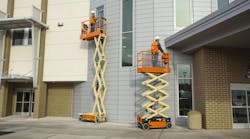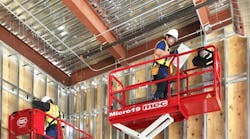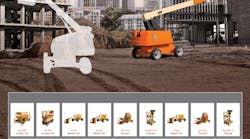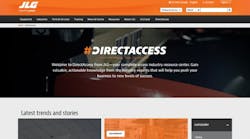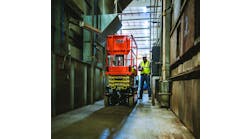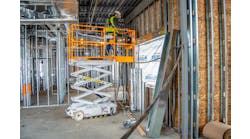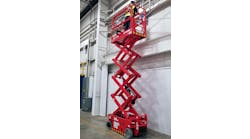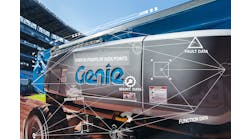RER talks with Jennifer Stiansen, director of marketing, JLG Industries about new technologies in its electric scissors, its variable tilt technology, building information modelling, the shortage of construction workers, virtual reality training, telematics developments and more.
RER: What are some of the new developments technologically in your company’s equipment during the past year?
Stiansen: We have implemented new technologies into our electric scissors, many of which are exclusive to JLG. We have two distinct lines for customers to choose from: The ES Series, with premium features including an efficient electric-drive system, and our value-driven hydraulic drive R Series, with a simplified active pothole protection system. In some instances, such as lubrication-free scissor arm bushings, the lines share common technologies to deliver maximum uptime.
Our exclusive variable tilt technology, included on both ES and R Series scissors, allows operators to elevate to limited heights when working on slight slopes, maximizing the work envelope.
Additional technologies included on JLG scissor lifts include:
- Controlled elevation descent, which cushions the ride for the operator when the scissor is coming to a stop on the way up or just before it reaches the bottom on the way down. This technology is included on both ES and R Series models.
- Controlled drive descent, included on both ES and R Series models, allows for smooth descents and protects machine components as customers traverse steep slopes.
- The 4045R, the narrowest machine in its size class, offers zero load calibration. Its pressure-based load sensing system (LSS) includes functionality for a simple calibration that can be performed in the field without calibrated weights. As a bonus, the JLG LSS is less sensitive to ambient temperatures, especially in cold-weather applications.
- Dual capacity is available on select ES Series models, providing customers and end users with the ability to take additional materials and tools to lower elevations up to the restricted capacity of the unit.
RER: What trends do you see on the horizon with your company’s equipment, and the industry as a whole?
Stiansen: Most recently, we added a BIM (building information modeling) library to our website. We know that BIM is transforming the architecture, engineering and construction industries, so we felt it was an important addition to the website to encourage communication and collaboration for our customers. All models in the library are available to download in a data-rich format. The main benefit of JLG BIM models is their ability to give design-build contractors and architects the opportunity to anticipate jobsite challenges they may face before breaking ground, allowing them to manage risk and eliminate guesswork on the front end of project planning. For rental companies, a major advantage of BIM is that very early on during a project, they can identify the equipment that will be required on the jobsite and plan for transportation before it’s needed. This will ensure that the right product is delivered on time to complete the work at hand.
Another trend or issue for the industry is attracting a new generation of construction workers. There’s been a lot of discussion around the aging workforce and a gap in skilled workers for all levels of the business. A job in the construction industry offers many benefits, and we want to do as much as we can to attract and retain new talent.
RER: The price of materials is rising with the recent implementation of tariffs from the Trump administration and by other countries in response. How big an impact will this have on manufacturing and on demand for aerial equipment in the marketplace?
Stiansen: We are experiencing an impact not only directly due to tariffs but also indirectly through increased domestic steel prices that developed as tariffs were being discussed. However, the construction and rental industries remain very strong, which is a strong signal for the continued health of the access segment.
RER: Safety continues to be an important topic in the aerial industry. What are some of the new safety developments on your company’s equipment and do you see any new developments on the horizon?
Stiansen: We continually talk to our customers and their customers to gain valuable insights into their constantly evolving equipment needs. JLG product developments are then prioritized to ensure we invest our research and development dollars in the technologies and product enhancements that will deliver the most value to owners and operators.
Safety remains of utmost importance to our company. As such, we have a number of technologies offered as standard equipment on our machines. We have our exclusive SkyGuard enhanced control panel protection system on all JLG boom lifts. Developed after extensive research and testing, the SkyGuard sensor, when activated by approximately 50 pounds (23 kg) of force, stops all functions in use at the time. After stopping the machine, it temporarily reverses, or “undoes” most functions that were in use at the time of activation. This reverse functionality is the only feature of its kind in the market.
We also continue to focus on training, which is a critical component to having a safe job site. We are also a big proponent of using virtual reality for training. We have an equipment simulator that provides VR-based training for operators of all skill levels, offering everything from controls familiarization to machine operation to advanced spatial awareness. The simulator helps to familiarize operators with the controls and operation techniques of boom lifts and telehandlers. A multiplayer version of the simulator enables two operators to interact with each other in real time while experiencing true-to-life job site scenarios as they maneuver equipment on mixed terrain, completing specific tasks in the same virtual environment.
We feel that these virtual training experiences not only engage users but give them the opportunity, in a low-pressure situation, to get hands-on experience, familiarize themselves with equipment controls and hone their ability to make decisions on a job site.
In addition, we have SmartLoad Technology, which is now available on JLG high-capacity telehandlers. SmartLoad Technology is a bundle of three integrated technologies. Included in the bundle is attachment recognition, which allows a telehandler to identify an attachment and display the appropriate load chart to the operator. The second technology, a load management information system (LMIS), graphically depicts a load’s location within the load chart, provides an indication of compliance and prevents the operator from violating the chart’s boundaries. A load stability indicator (LSI) completes the technologies, working with the LMIS to limit operation when a load becomes noncompliant. Combining attachment recognition with real-time load data gives operators greater confidence during operation and protects fleets by giving operators additional guidance on load capabilities.
The international demand for aerial equipment continues to grow as people in different countries and industries become more aware of the benefits of aerial equipment. What might be some of the breakthrough areas in usage of aerials in the foreseeable future?
Stiansen: Emerging markets tend to mirror mature markets in terms of equipment adoption. In general, as the world’s population increases, there’s greater demand to build up vs. out, at least in urban areas. This will continue to fuel demand for aerial equipment and safer methods for completing work at height.
New ANSI standards are expected to be published later this year. Can you summarize the impact the new standards will have on the aerial rental industry?
Stiansen: Changes to A92.20 are expected to be published in the coming months and have been the catalyst of much discussion within the equipment industry. Equipment manufacturers will have one year from the date of publication to incorporate the required changes into their aerial products and training materials.
Rental companies must do the following as a result of the standards:
- Update training procedures to support new requirements
- Offer familiarization to customers any time they rent, lease or buy equipment
- Train technicians on new machine features
- Update onboard manuals of responsibilities
Changes to A92.20 are expected to include:
- Sustained Involuntary Operation: Hand-operated controls in the platform will be required to protect against sustained involuntary operation. This will may result in additional protection systems at platform controls.
- Load Sensing: Machines will be required to actively monitor load and interrupt normal operations and sound an alarm if overloaded. This will result in new systems to monitor platform loads.
- Wind Force Requirements: To be rated for outdoor use, machines will need to meet stability requirements that include 28-mph winds. This may require reduced platform capacities and/or increased weight for additional stability.
- Pneumatic Tire Requirements: Stability considerations for failure of pneumatic tires will be added. As a result, many machines will only be available with solid and/or foam-filled tires.
- Tilt Sensing Requirements: Machines that could previously only operate on level surfaces will be used on slopes but are required to have a tilt sensor alarm and function cutout. The system will disable boom and drive functions if the incline surpasses the slope limit.
- Entrance Gates: Flexible devices, like chains, will no longer be acceptable entrance gates, and toe boards will be required on all areas of the platform.
- Platform Railings: The railing height requirement will be raised for small indoor scissor lifts. To fit through standard doorways, folding rails will replace fixed, non-folding rails on select models.
Any other trends you are seeing or expect in the aerial rental industry?
Stiansen: There is increasing demand for smart technologies that improve the efficiency and productivity of machines. These smart technologies paired with data gathered through telematics, wearables, BIM modeling and other onsite tools are expected to change the way job sites are managed and equipment selected in the years to come. We are also seeing continued interest in hybrid models due to their environmentally friendly and energy-efficient operation. We anticipate increased interest in hybrid and energy-efficient access equipment moving forward.
Compact crawler booms (CCBs) are gaining increased use in utility and facility maintenance applications due to their ease of portability, compact size and ability to be used indoors or outdoors with minimal impact to sensitive flooring or grounds.
JLG® EcoLift™ and LiftPod® low-level access products continue to gain momentum in replacing scaffolding and ladders in industrial and facility maintenance applications. These products reduce setup time for improved productivity and provide a safer solution for working at height over traditional ladders and scaffolding.
